Going back to TOE aka string theory, I saw the IMAX documentary on the subject once and whoa, as much as I tried, I just couldn't grasp it. It's far too sci-fi for me and I thought the theoretical physicists behind it are so hungry for a long overdue breakthrough as powerful as the Einstein and Neils Bohr breakthroughs almost a century ago, they are grasping at straws. Why the need to unify quantum theory and gravity anyway? Why does one law have to govern the infinitesimally small and the unimaginably large? Is it not possible for both to exist independent of each other?
The Ekpyrotic UNIverse
Moderator: ttommy
30 posts
• Page 2 of 2 • 1, 2
You guys are deep. 
Going back to TOE aka string theory, I saw the IMAX documentary on the subject once and whoa, as much as I tried, I just couldn't grasp it. It's far too sci-fi for me and I thought the theoretical physicists behind it are so hungry for a long overdue breakthrough as powerful as the Einstein and Neils Bohr breakthroughs almost a century ago, they are grasping at straws. Why the need to unify quantum theory and gravity anyway? Why does one law have to govern the infinitesimally small and the unimaginably large? Is it not possible for both to exist independent of each other?
Going back to TOE aka string theory, I saw the IMAX documentary on the subject once and whoa, as much as I tried, I just couldn't grasp it. It's far too sci-fi for me and I thought the theoretical physicists behind it are so hungry for a long overdue breakthrough as powerful as the Einstein and Neils Bohr breakthroughs almost a century ago, they are grasping at straws. Why the need to unify quantum theory and gravity anyway? Why does one law have to govern the infinitesimally small and the unimaginably large? Is it not possible for both to exist independent of each other?
- desmo
- Citizen

- Posts: 918
- Joined: Tue May 13, 2003 11:42 am
- Location: Manila
desmo
The 2 classics in this topic for me is A Brief History of Time by Hawkings and Cosmos by Sagan.
On a more recent note, Wired Magazine with the recent black cover has some good stuff that's easy enough even for me to read while on a treadmill.
The 2 classics in this topic for me is A Brief History of Time by Hawkings and Cosmos by Sagan.
On a more recent note, Wired Magazine with the recent black cover has some good stuff that's easy enough even for me to read while on a treadmill.
-

rtsyrtsy - Moderator
- Posts: 3908
- Joined: Tue Jan 28, 2003 5:25 am
desmo wrote: Why does one law have to govern the infinitesimally small and the unimaginably large? Is it not possible for both to exist independent of each other?
It does. It's just that nobody can explain how or why.
Could it be more tools are needed? Ehem. Tito. Ito na ang segue mo....
-

JackD201 - Immortal
- Posts: 10024
- Joined: Sat Oct 09, 2004 12:10 am
- Location: Bozania
desmo wrote: Why does one law have to govern the infinitesimally small and the unimaginably large? Is it not possible for both to exist independent of each other?
Good question, for the most part, both theories don't step on each other's bunions (russ, I know you hate this imagery... so I'll drop it na
Either situation is like that itch that physicists can't help but scratch. Fortunately, superstring theory accommodates both by promising to be a more fundamental theory. To use an analogy, it's like another fundamental structure, the biological DNA, which is used to differentiate everything from the very large to microscopically small species in the animal kingdom. (Although this analogy is far from perfect primarily because it is easy to detect DNA, not so with strings.)
Jack, thanks for your candor, e.g.--
JackD201 wrote:What has been a serious concern for me is what a chore it has become. Reviews in particular have become boring and uninformative...
Indeed, there's a challenge. I think the only way writing doesn't feel like a "cut-and-paste" chore is if one doesn't detach the person from the reviewer. I prefer a writer who brings his or her personality and experiences, biases and eccentricities and hopefully garnishes the technical meat with a touch of controversy and local color.
I feel that the current lexicon is no longer sufficient to put into words what the systems of today are more increasingly and consistently capable of despite an explosion of diversity in design and implementation.
Well some of the imagery is very creative, e.g Valin's comparison of ARC and mBL reference amps in terms of decay-- on one hand, he says ARC "decays gradually" until the sound fades completely, on the other hand, with mBL that last moment feels like a "bank vault getting shut." Man, I love that, that's the kinda stuff they pay for.
The urge to be reductionist is strong and some may say indispensible because it is for the consumption of the least common denominator, the layman.
But I think it's possible for the layman to arrive at the same type of "seeing" outside the reductionist/analytical methods used by science. In the evolution of Visual Art, for example, I think conceptions of "underlying surfaces" often coincided with-- and even presaged!-- discoveries by their scientific counterparts. So we have "flat" paintings vs the belief that the world is flat; development of perspective and the classical "realist" revival during the Renaissance vs Copernicus' discovery; non-Euclidian geometry and Riemann surfaces vs "deconstruction" of natural surfaces in Cubism and Surrealism; Pollock's Abstract Expressionism vs the "white noise" of quantum foam; Escher spaces vs Calabi Yau manifolds... In short, whether it's science or art, I think their practitioners are on equal footing. Furthermore, between these two ways of "seeing," there is hardly an excuse for inaccessibility and that "layman" simply has no choice but to evolve
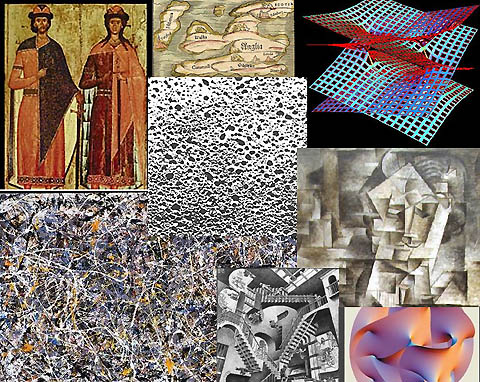
Last edited by ttommy on Wed Mar 14, 2007 1:32 pm, edited 2 times in total.
- ttommy
- Citizen

- Posts: 943
- Joined: Sat Aug 30, 2003 8:27 am
ttommy wrote:The urge to be reductionist is strong and some may say indispensible because it is for the consumption of the least common denominator, the layman.
But I think it's possible for the layman to arrive at the same type of "seeing" outside the reductionist/analytical methods used by science. In the evolution of Visual Art, for example, I think conceptions of "underlying surfaces" often coincided with-- and even presaged!-- discoveries by their scientific counterparts. So we have "flat" paintings vs the belief that the world is flat; development of perspective and the classical "realist" revival during the Renaissance vs Copernicus' discovery; non-Euclidian geometry and Riemann surfaces vs "deconstruction" of natural surfaces in Cubism and Surrealism; Pollock's Abstract Expressionism vs the "white noise" of quantum foam; Escher spaces vs Calabi Yau manifolds... In short, whether it's science or art, I think their practitioners are on equal footing. Furthermore, between these two ways of "seeing," there is hardly an excuse for inaccessibility and that "layman" simply has no choice but to evolve
Quite true. The layman is constantly evolving. This includes rocket scientists learning bonzai. Everybody is a layman at something right?
The question now is how these existing paradigms are shifted. First and foremost is widespread communication of the "next big thing". In a society where viable sources of information are spreading in an inverse relationship with the attention spans of those that seek them, the reductionist instinct has never been stronger.
We live in the era of the soundbite. Aaaaargh.
In an interview with the press I was asked me as the Secretary General/ Spokesman/ Messenger / Errand Boy/ Designated Moving Target why our political party is so quiet and appears to be just lurking in the sidelines. I said it is because what we're doing, which is just simply working, doesn't sell papers or make for exciting news. No hero and no bad guy makes for no drama I guess. We are not quiet you just don't give us any media mileage.
"Huh? Hindi naman sir!"
I said "okay here's just one example. We are working on land reform models that will do away with the wasteful, unsustainable model in use today by corporatizing farms with a mix of Cooperative, Local Government and Private Corporate ownership with the hopes of providing economies of scale by consolidating larger arrable tracts, bringing post harvest processing and packaging to the farms and creating domestic and international market opportunities. In the end we hope to be able to create an environment where we can have a commodities board at the stock exchange to enable cheaper money for expansion and modernization." (This by the way is no pipedream. It's a program being piloted in mindanao and is proving to be very lucrative for the farmers and investors alike. We are now defining process so it can be replicated.)
"Ay very technical pala sir. Sayang" Needless to say it got zero airtime and no print. Go figure.
I could have just said "We are working to put money in your pockets and food on your plates" but really anybody who'd see it would just call us "politicking a-holes out to fool the public with empty promises"
So as in physics, art, audio I guess we just have to keep on moving while hoping others finally take notice and "get hip".
I've observed that for people to "see outside" the finished work must be on display. Then they get hip! It is unlikely that the layman presented with only fragments and rough sketches, presented with what precious little is observable with todays tools can truly grasp the enormity of what might be or even just what might be possible.
So, does a stylus move laterally or does it move in a spiral?
-

JackD201 - Immortal
- Posts: 10024
- Joined: Sat Oct 09, 2004 12:10 am
- Location: Bozania
Talking about interesting discoveries that may antidate the big bang theory or look like it is from Esteban Rodriguez of the Legaspi Expedition. It's short of busting the big bang theory but looks ekpyrotic anyway. That's if you're enough of a science buff than a man of faith.
Sailing off the coast of Bohol, this intrepid Spaniard missionary marveled at seeing from a distance an island that glowed like God's Shekinah glory at mount Horeb. Upon reaching it though, his old world sci- fi perspective got busted when he learned that fireflies had swarmed the place to give it that unusual luminiscene. To his old Princetonian delight, he named the island "Isla Del Fuego." Would you know what Island off Cebu and Bohol is this?
Sailing off the coast of Bohol, this intrepid Spaniard missionary marveled at seeing from a distance an island that glowed like God's Shekinah glory at mount Horeb. Upon reaching it though, his old world sci- fi perspective got busted when he learned that fireflies had swarmed the place to give it that unusual luminiscene. To his old Princetonian delight, he named the island "Isla Del Fuego." Would you know what Island off Cebu and Bohol is this?
- ichabod
- Fanatic

- Posts: 1824
- Joined: Fri May 16, 2003 9:09 am
ichabod wrote:Sailing off the coast of Bohol, this intrepid Spaniard missionary marveled at seeing from a distance an island that glowed like God's Shekinah glory at mount Horeb. Upon reaching it though, his old world sci- fi perspective got busted when he learned that fireflies had swarmed the place to give it that unusual luminiscene. To his old Princetonian delight, he named the island "Isla Del Fuego." Would you know what Island off Cebu and Bohol is this?
That's a cool story. I know very little about that island and find it intriguing. Perhaps we'll delve into this next time, there seems to be a good mix of familiarity and taboo behind its "mythology" that makes the subject both fascinating and scary.
Thanks too for that anecdote, Jack, your personal angle is valuable to a passive layman/observer like myself. Despite the challenges, however, I do believe you thrive in that struggle where each action is its own reward. And even if that "finished work on display" can't avoid becoming a political target, hopefully, the countervailing agenda behind media is distributed enough that spin balances out and leaves you with a level playing field... even one without spectators
So, does a stylus move laterally or does it move in a spiral?
I'll take this as a cue to wrap up... which I promise to do after a final digression into one particular "tool". While having a few tools have indeed helped (although at times I felt I was hearing them more than the cart), between the Stereovox and Davinci speaker cables, switching to a more familiar cart (the RSP) and the Kharma amps, it's the MP150s that helped me get a fix on the Zyx.
First, let's start by comparing the MP150s to what I've been using, the Bel Canto M300s. At the end of this review, you'll probably find it ironic that I have more to report about this tool than what it was supposed to help "observe"
Where the Bel Canto holds its own (and I suspect ICEpower in general) is having smoother, more euphonic mids, which made for an easier learning curve for a tube fan like myself. On the other hand, the MP150s are significantly more transparent and don't suffer from that "truncated" top end some reviewers seem to find endemic in Class D.
The biggest surprise, however, was in how the Kharma handles the L707s woofer, controlling it very gracefully while lending a sensation as if the amp is "dynamically adjusting" damping factor depending on the woofer's impedance at the frequency being played along with the back EMF the driver generates! The result isn't so much lack of overhang than better timbral continuity and reduced smear between the subwoofer and woofers.
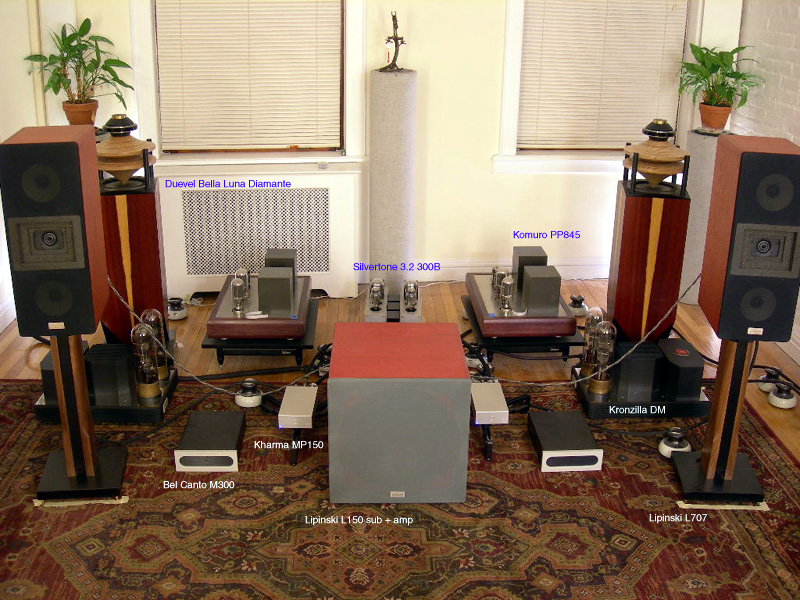
In terms of resolution, the Bel Canto resolves like an good tube amp but the push-pull variety. In comparison, the MP150 resolves like a good solid-state amp BUT it images like a single-ended! Tonally, the Bel Canto isn't as far behind as I first imagined and, if paired with leanish speakers, might be preferable to the MP150s. Playing my bias-- guitar music-- on both amps, it's a toss up in terms of tonality. However, on piano and orchestral, the top extension and superb resolution of the MP150s come into play and there's no contest.
So far there are two possible weaknesses I've noticed with the Kharmas-- first, I think it's much easier to voice them "dry" than to get them to sound liquid. I think this is more a character of the technology (heard it with Hypex as well, a predecessor design of the MP150 if you will) so one has to be careful pairing this amp with "inert" speakers as it's possible for this character to be overemphasized. I must also admit that while the Lipinskis do a very credible disappearing job, there are times when the Kharmas allow me to hear "baffle walls".
The other weakness is possible susceptibility to RF noise. Although rare and intermittent, I've noticed a very high frequency noise from both tweeters that's difficult to isolate (because after changing something the noise might disappear momentarily then return much later when no music is played). I've narrowed this down to a couple suspects but I think the culprit is still at large... even if it hasn't surfaced for two days. In summary, the Kharma MP150 is a formidable amplifier and seems up to the task for penetrating the UNIverse of Zyx. Stay tuned.
- ttommy
- Citizen

- Posts: 943
- Joined: Sat Aug 30, 2003 8:27 am
The Tao of Zyx
What I love most about this hobby, perhaps more than the deep emotional meaning of music, way beyond insights into technique, is that it always makes me feel like a beginner.
Take the idea of a vacation. After deciding where to go, what's the first thing we prepare? Our itinerary-- a set of points plotted along a bounded terrain of expectation... where the experience re-lived through its retelling one often imagines as the adventure unfolds. After all, where's the fun in returning if no one knew you had left? So, we "quip"-- "hey, next time you're in Boracay don't miss Mango Ray's mango shake. Absof*ckinglutely to die for!"
Then we return, same place, another time: "eh, Mango Ray's owner used to play Hermeto Pascoal but now it's all Bob Marley. Yeah, the mango shakes are still fantastic... just that... well, there's those teenage hipsters making the place home base... a totally different vibe, man." The sense of dislocation too familiar. The experience feels poorer. So Boracay slips a notch. "Sorry to hear, dude, but things change.""
Then circling the room, we find that friendly cynic guarding the door to discourse, expecting adherence to formula: "ah, ye ole allusion to human weakness, nice. The "familiar" vs the "unknown" at the root of our "vacation," eh? As opposed to your audiophile "journey," right? But let's get over it shall we? Our subject is waiting. Quip. Then wrap up."
Wait. I really meant what I said, I am that beginner. I wonder and pontificate. Shiver and blush. Ornament mistakes. Talking about sounding good... while sounding bad. Making those excuses about "not hearing"... while writing... and not listening... Avoiding "formula"... yet, hoping your attention is held between my storytelling device and this lame "I am a beginner" excuse. Is there anything to be said you don't already expect?
But the beginner's privilege in "not having seen before" is that one doesn't have to see the way it's always been. For example, take the embedded geometry in tungsten--
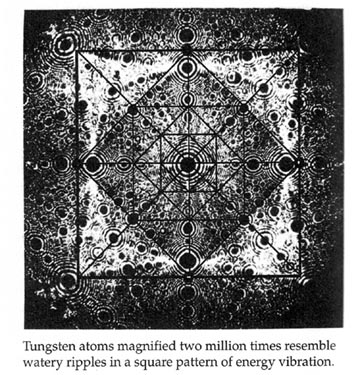
Then step back and build up that inlaid pattern through a series of squares within squares. Surely one could derive some mathematical formula describing some kind of "harmonic" relationship within this square-series.
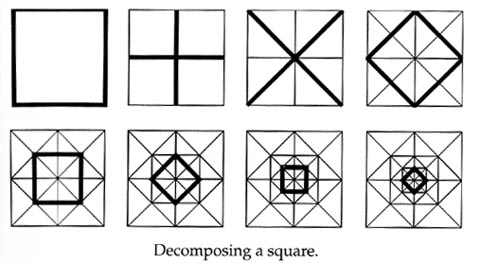
Then mentally paint each enclosed square a different color. Also remember that, hey, used as filaments, tungsten "resonates" with visible light! Put another way, the resonant frequencies of tungsten produce the entire spectrum of visible light. Surely we've seen this spectrum before. But what about its geometry?
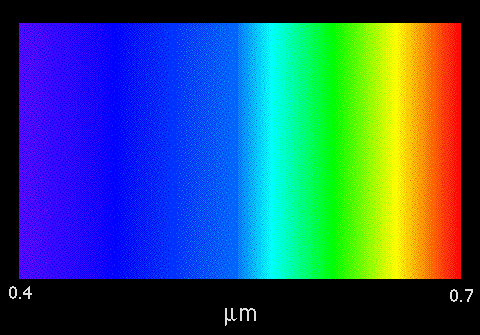
Now let's bring the context home. I'm sure you've seen this popular chart showing the relationship between a tonearm's (+ headshell + cartridge's) effective mass, the cartridge's compliance and the system's resonant frequency. Since all things resonate, like particles borne out of strings, the idea is to tune the tonearm-cartridge system's resonant frequency below audible levels, ideally, in that region below the turntable's so-called wow and flutter.
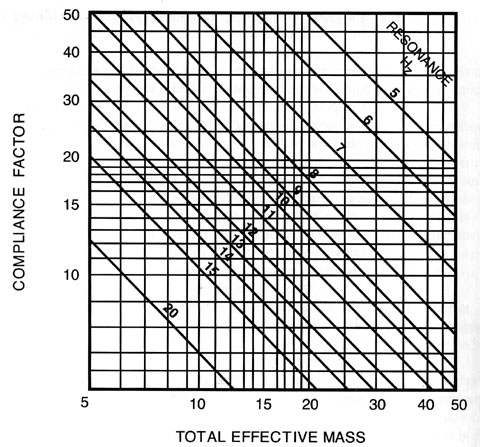
But then let's borrow that idea of "adding" a dimension to our resonant frequency formula (i.e. 159/sqrt(Compliance*Effective Mass of tonearm-cart system). Add a few lines of code to generate a table and its surface. Then we'll forget that formula and just stare at geometry and shape below.
Placing the Zyx on its calculated resonant spot, we can imagine an extruded surface looking like a bowl. Going even further, one might even visualize the problem of tuning resonance in terms of tuning "azimuth!" Since our bowl surface has an exaggerated vertical axis, it's easier to see when the cart starts to tip--
Since our bowl surface has an exaggerated vertical axis, it's easier to see when the cart starts to tip--
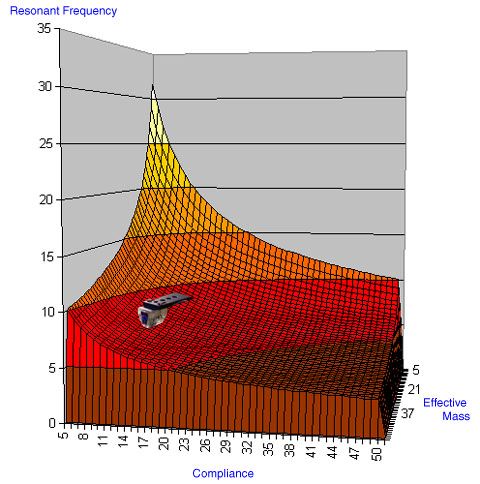
Still, that's not the point! What is implied is that our resonant-frequency "problem space" can be approached by either studying that resonance formula or, alternatively, visualizing its surface. I simply prefer the fun in the latter.
Then we go further. A turntable system can be thought of as a mashed-up complex system of equations, not unlike the mashup of branes. That equation describing the tonearm-cartridge resonant frequency is one of these equations together with the mathematics for encoding stereo or mono, perhaps an "approximation" model describing the effect of the playback chain on the input signal and, arguably, lightest in terms of "influence", the resonant character of the cartridge itself--
The Zyx UNIverse has its distinct resonant character. Influenced by the material in its body we can borrow the formula we had earlier and substitute abstract units of "transparency" and "speed" for "effective mass acting on compliance" and still won't notice an inverse relationship with frequency (if anything, with this cart, the opposite is true). That might not sound like a good thing but, bear in mind, there's no other cart that can ride the saddle of this UNiverse.
Thanks for reading!
What I love most about this hobby, perhaps more than the deep emotional meaning of music, way beyond insights into technique, is that it always makes me feel like a beginner.
Take the idea of a vacation. After deciding where to go, what's the first thing we prepare? Our itinerary-- a set of points plotted along a bounded terrain of expectation... where the experience re-lived through its retelling one often imagines as the adventure unfolds. After all, where's the fun in returning if no one knew you had left? So, we "quip"-- "hey, next time you're in Boracay don't miss Mango Ray's mango shake. Absof*ckinglutely to die for!"
Then we return, same place, another time: "eh, Mango Ray's owner used to play Hermeto Pascoal but now it's all Bob Marley. Yeah, the mango shakes are still fantastic... just that... well, there's those teenage hipsters making the place home base... a totally different vibe, man." The sense of dislocation too familiar. The experience feels poorer. So Boracay slips a notch. "Sorry to hear, dude, but things change.""
Then circling the room, we find that friendly cynic guarding the door to discourse, expecting adherence to formula: "ah, ye ole allusion to human weakness, nice. The "familiar" vs the "unknown" at the root of our "vacation," eh? As opposed to your audiophile "journey," right? But let's get over it shall we? Our subject is waiting. Quip. Then wrap up."
Wait. I really meant what I said, I am that beginner. I wonder and pontificate. Shiver and blush. Ornament mistakes. Talking about sounding good... while sounding bad. Making those excuses about "not hearing"... while writing... and not listening... Avoiding "formula"... yet, hoping your attention is held between my storytelling device and this lame "I am a beginner" excuse. Is there anything to be said you don't already expect?
But the beginner's privilege in "not having seen before" is that one doesn't have to see the way it's always been. For example, take the embedded geometry in tungsten--

Then step back and build up that inlaid pattern through a series of squares within squares. Surely one could derive some mathematical formula describing some kind of "harmonic" relationship within this square-series.

Then mentally paint each enclosed square a different color. Also remember that, hey, used as filaments, tungsten "resonates" with visible light! Put another way, the resonant frequencies of tungsten produce the entire spectrum of visible light. Surely we've seen this spectrum before. But what about its geometry?

Now let's bring the context home. I'm sure you've seen this popular chart showing the relationship between a tonearm's (+ headshell + cartridge's) effective mass, the cartridge's compliance and the system's resonant frequency. Since all things resonate, like particles borne out of strings, the idea is to tune the tonearm-cartridge system's resonant frequency below audible levels, ideally, in that region below the turntable's so-called wow and flutter.

But then let's borrow that idea of "adding" a dimension to our resonant frequency formula (i.e. 159/sqrt(Compliance*Effective Mass of tonearm-cart system). Add a few lines of code to generate a table and its surface. Then we'll forget that formula and just stare at geometry and shape below.
Placing the Zyx on its calculated resonant spot, we can imagine an extruded surface looking like a bowl. Going even further, one might even visualize the problem of tuning resonance in terms of tuning "azimuth!"

Still, that's not the point! What is implied is that our resonant-frequency "problem space" can be approached by either studying that resonance formula or, alternatively, visualizing its surface. I simply prefer the fun in the latter.
Then we go further. A turntable system can be thought of as a mashed-up complex system of equations, not unlike the mashup of branes. That equation describing the tonearm-cartridge resonant frequency is one of these equations together with the mathematics for encoding stereo or mono, perhaps an "approximation" model describing the effect of the playback chain on the input signal and, arguably, lightest in terms of "influence", the resonant character of the cartridge itself--
The Zyx UNIverse has its distinct resonant character. Influenced by the material in its body we can borrow the formula we had earlier and substitute abstract units of "transparency" and "speed" for "effective mass acting on compliance" and still won't notice an inverse relationship with frequency (if anything, with this cart, the opposite is true). That might not sound like a good thing but, bear in mind, there's no other cart that can ride the saddle of this UNiverse.
Thanks for reading!
- ttommy
- Citizen

- Posts: 943
- Joined: Sat Aug 30, 2003 8:27 am
30 posts
• Page 2 of 2 • 1, 2
Who is online
Users browsing this forum: No registered users and 2 guests

